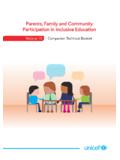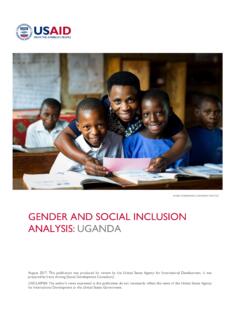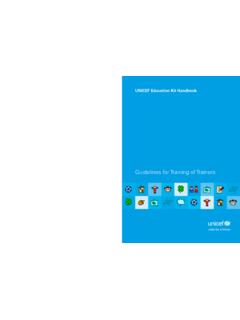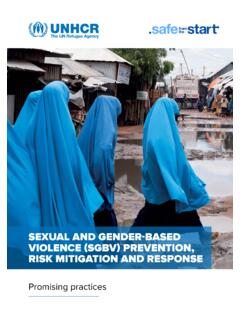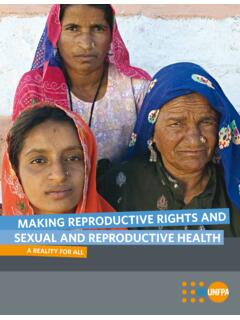Transcription of Minimum Initial Service Package (MISP) Reproductive Health ...
1 Minimum Initial Service Package (MISP) for Reproductive Health in Crisis Situations:A Distance Learning ModuleMinimum Initial Service Package (MISP) for Reproductive Health in Crisis Situations: A Distance Learning Module The Women's Refugee Commission advocates for laws, policies and programs to improve the lives and protect the rights of refugee and internally displaced women, children and young people, including those seeking asylum bringing about lasting, measurable change. Through research and fact-finding field missions, the Women s Refugee Commission identifies critical problems that affect displaced women, children and young people, including gaps in life-saving Reproductive Health care, lack of dignified livelihoods for refugees and, in the , the treatment of asylum-seekers.
2 We document best practices, and propose solutions and develop innovative tools to improve the way humanitarian assistance is delivered in crisis-affected or humanitarian settings. On Capitol Hill, at the United Nations (UN) and with humanitarian organizations, governments and donors, we push for improvements in refugee policy and practice until measurable long-term change is Women s Refugee Commission was founded in 1989 under the auspices of the International Rescue Committee (IRC). The organization is legally part of the IRC but receives no funding or direction from them. The original 2007 MISP distance learning module was principally developed by Julia Matthews, formerly of the Women s Refugee Commission, Sandra Krause of the Women s Refugee Commission and Sarah Chynoweth of the International Planned Parenthood Foundation (IPPF); Diana Quick of the Women s Refugee Commission provided project and editorial oversight.
3 The current MISP module is based on the Inter-agency Working Group (IAWG) on Reproductive Health in Crises, Inter-agency Field Manual on Reproductive Health in Humanitarian Settings: 2010 Revision for Field Review, Chapter 2: Minimum Initial Serve Package (MISP).This version of the MISP distance learning module was revised by Sandra Krause and Sarah Chynoweth, and edited by Diana Quick. Many thanks to the following IAWG colleagues for their contributions to the 2011 revision of the MISP Distance Learning Module: Ribka Amsalu, Wilma Doedens, Brad Kerner, Cecile Mazzacurati, Chen Reis, Marian Schilperoord and Mihoko Tanabe. The original MISP module was made possible by the generous support of The Bill & Melinda Gates Foundation; while the current revision was made possible by the United Nations Population Fund (UNFPA), the Reproductive Health Access Information Services in Emergencies (RAISE) Initiative, and the Australian Government s Overseas Aid ProgramConcept, Design & Production:Green Communication Design inc.
4 : Date September 2006 Revised November 2007 Revised February 20111A Distance Learning ModuleTable of ContentsAbout the MISP Distance Learning Module 3 Introduction 6 Chapter 1: What Is the MISP? 8 Chapter 2: Coordination of the MISP 15 Chapter 3: Prevent and Manage the Consequences of Sexual Violence 23 Chapter 4: Reduce the Transmission of HIV 35 Chapter 5: Prevent Excess Maternal and Neonatal Mortality and Morbidity 46 Chapter 6: Planning for Comprehensive RH Services 56 Chapter 7: Priority Activities in Addition to the MISP 63 Chapter 8: Ordering Reproductive Health Kits 69 Frequently Asked Questions 78 Scenarios for Implementing the MISP 80 MISP Module Post-Test 83 Appendix A: MISP Check-list 86 Appendix B: MISP Calculator 89 Appendix C: Sample Project Proposal 91 Appendix D: Sample Funding Proposal for the Consolidated Appeals Process (CAP) 95 Appendix E: MISP Cheat Sheet 99 Appendix F.
5 MISP Advocacy Sheet 101 AppendixG: Adolescent-friendly Checklist 103 MISP Module Answers 104 Minimum Initial Service Package (MISP) for Reproductive Health in Crisis Situations2 Acronym ListAIDS Acquired Immunodeficiency SyndromeAMPATH Academic Model for the Prevention and Treatment of HIVAoR Area of responsibilityARHA Australian Reproductive Health AllianceBPRM Bureau for Population, Refugees and MigrationCAP Consolidated Appeals ProcessCBR Crude birth rateCDC Centers for Disease Control and PreventionCERF Central Emergency Response FundCIVPOL Civilian policeCoC Code of conductCHAP Common Humanitarian Action PlanDHS Demographic Health SurveyESEAOR East South-East Asia and Pacific RegionEC Emergency contraceptionECHO Humanitarian Aid Office of the European CommissionEmOC Emergency obstetric careGBV Gender-based violenceHIS Health Information SystemHIV Human Immunodeficiency VirusHLD High level disinfectionHRB Humanitarian Response BranchIASC Inter-Agency Standing CommitteeIAWG Inter-agency
6 Working Group (on Reproductive Health in Crises)ICRC International Committee of the Red CrossIEC Information, education and communicationIEHK Interagency Emergency Health KitIFRC International Federation of the Red Cross and Red Crescent SocietiesIUD Intrauterine devicesMSF M decins Sans Fronti resMISP Minimum Initial Service Package (for Reproductive Health )MoH Ministry of HealthMoU Memorandum of UnderstandingNGO Nongovernmental organizationOFDA Office of Foreign Disaster AssistancePAHO Pan American Health OrganizationPEP Post-exposure prophylaxisPHC Primary Health carePCWG Protection cluster working groupPMTCT Prevention of mother-to-child transmission (of HIV)RH Reproductive healthRHRC Reproductive Health Response in Crises (Consortium)SOP Standard operating procedureSPRINT Sexual and Reproductive Health Programme in Crisis and Post-Crisis SituationsSTI Sexually transmitted infectionTBA Traditional birth attendantTP Training Partnership (IAWG Initiative)
7 UN United NationsUNAIDS Joint United Nations Program on HIV/AIDSUNFPA United Nations Population FundUNHCR United Nations High Commissioner for RefugeesUNICEF United Nations Children's FundUNOCHA United Nations Office for the Coordination of Humanitarian AffairsUNSW University of New South WalesVCT Voluntary counseling and testing (for HIV)WG Working groupWHO World Health OrganizationWRA Women of Reproductive age3A Distance Learning ModuleAbout the MISP Distance Learning ModuleThe Minimum Initial Service Package (MISP) for Reproductive Health (RH) is a coordinated set of priority activities designed to prevent and manage the consequences of sexual violence; reduce HIV transmission; prevent excess maternal and newborn morbidity and mortality; and plan for comprehensive RH services.
8 Additional priority activities of the MISP include making contraceptives available to meet demand, syndromic treatment for sexually transmitted infections (STIs) and ensuring antiretrovirals (ARVs) for continuing users. The MISP distance learning module aims to increase humanitarian actors knowledge of these priority RH services to initiate at the onset of a crisis and to scale up for equitable coverage throughout protracted crises and recovery, while planning for comprehensive RH services and implementing them as soon as possible. The MISP was first articulated in 1996 in the field test version of Reproductive Health in Refugee Situations: An Inter-agency Field Manual,1 a resource developed by the IAWG on Reproductive Health in Crises.
9 The MISP was then updated and revised in the Inter-agency Field Manual on Reproductive Health in Humanitarian Settings: 2010 Revision for Field Review (Field Manual). Founded in 1995 and formerly known as the IAWG on Reproductive Health in Refugee Situations, the IAWG seeks to advance the RH of women, men and adolescents in humanitarian settings. IAWG is currently led by a steering committee of 12 agencies that includes representatives of UN agencies, national and international non-governmental organizations (NGOs) and academic organizations. It has more than 800 members on its listserv. Unless a specific reference is given, the information provided in the MISP module is based on the IAWG s 2010 Field Manual, which provides specific guidelines on how to address the RH needs of displaced populations from the Initial emer-gency through to reconstruction and development.
10 The MISP is a standard in the Sphere Minimum Standards in Disaster Response2 and is integrated into the Inter-agency Standing Committee (IASC) Health Cluster tools and is the MISP Module designed for?The module incorporates a multi-sectoral set of activities to be implemented by humanitarian workers operating in Health , camp design and management, community services, protection and other sectors. The MISP module is particularly useful for members of emergency response teams and other humanitarian first responders in crisis settings as it focuses on populations displaced by crises, such as armed conflict and natural disasters. Although the MISP module is most relevant to those working in emergency settings, it can also be referenced when scaling up services to ensure equitable coverage in protracted crises and recovery.










